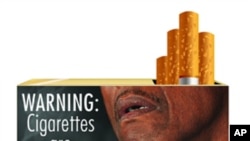The U.S. Food and Drug Administration (FDA), the government agency which regulates food, drugs - and tobacco - has released new health warnings for U.S. cigarette packs. The warnings consist of graphic photos and messages, which must cover half of each cigarette package and make up 20 percent of each tobacco ad. Health experts note that the United States was the first country to require health warnings on tobacco but is now playing catch-up with more than 30 countries which have already made such warnings mandatory. They say the new mandate is long overdue.
The Food and Drug Administration says the super-sized warning images must be displayed on cigarette packages and in advertisements no later than September of next year. Margaret Hamburg is the FDA's commissioner:
“These graphic warning labels are really intended to reach a wide range of smokers and potential smokers,” Hamburg said.
The warnings represent one of the most significant changes in cigarette labels in more than 25 years. There are nine different photos - including rotting teeth and an autopsied body - and they will cover the upper half of both sides of the pack.
Health and Human Services Secretary Kathleen Sebelius says they will be the toughest and most effective messages about tobacco dangers ever. “With these warnings - every person who picks up a pack of cigarettes is going to know exactly what risk they're taking,” Sebelius said.
Smoking rates in the United States have declined significantly since the 1960s. But the Centers for Disease Control and Prevention (CDC) says 46 million Americans - one in five - still smoke and about 443,000 Americans die each year of tobacco related illnesses. The CDC says smoking is responsible for 90 percent of all lung cancer deaths in men and 80 percent among women.
Dr. Thomas Frieden, Director of the CDC, says the multi-billion dollar U.S. tobacco industry is always looking for new markets, and it is turning its attention overseas.
“In countries of Africa where smoking is not prevalent they see the potential of increasing smoking rate and in case of countries like China where smoking remains prevalent they would like to maintain the smoking rate,” Frieden said.
Health experts say that graphic images and warnings can counter the impression that smoking is glamorous or "cool." Studies have shown that similar campaigns have significantly lowered tobacco use in Uruguay, Brazil, Canada and Australia.
“Experience from a variety of countries from around the world shows that with political will and focused action we can save more than a 100 million lives over the coming decades,” Frieden said.
In a statement to the FDA, tobacco companies opposed the new warnings, arguing that the mandate violates their constitutional right to free speech. And they say that by requiring them to cover half their packaging with the graphic images, the government is not warning consumers about the risks of smoking but telling them not to buy or use the product.
Health Experts Welcome Graphic New Warnings on US Cigarette Packages








